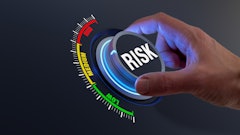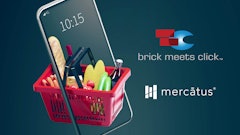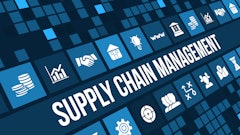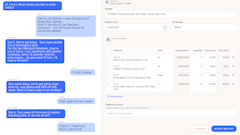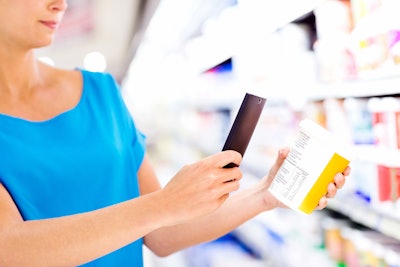
The emergence of smart labels has been an important development in the food supply chain, connecting products to improve visibility, compliance with food safety regulations and enhance shelf life. Beyond these essential benefits for all players in the food and beverage industry, smart labels also offer that same transparency at the consumer level, giving shoppers insight into how their food was treated on its journey to the store shelf.
A smart label is any label that acts as a conduit to provide additional intelligence beyond what is readable by the human eye. Code-enabled smart labels and products are connected to a digital platform, enabling companies to collect data and respond to consumer interactions.
Log in to view the full article
The emergence of smart labels has been an important development in the food supply chain, connecting products to improve visibility, compliance with food safety regulations and enhance shelf life. Beyond these essential benefits for all players in the food and beverage industry, smart labels also offer that same transparency at the consumer level, giving shoppers insight into how their food was treated on its journey to the store shelf.
A smart label is any label that acts as a conduit to provide additional intelligence beyond what is readable by the human eye. Code-enabled smart labels and products are connected to a digital platform, enabling companies to collect data and respond to consumer interactions.
Near field wireless communication technology (NFC), which is available in all smartphones, is one of the most common technologies embedded into labels to make them “smart,” because it can easily connect a consumer directly to additional information about a product.
“By tapping the smartphone to the label, the consumer can be brought to additional information such as recipes or ingredient information,” explains Amy Childress, vice president of marketing and planning, Cargo Solutions, Emerson Commercial & Residential Solutions. “We’ve seen these types of labels connect users directly to a brand experience dictated by the brand owner.”
Answering Consumer Demand for More
The proliferation of smartphone use is making the case for direct brand to consumer transparency a reality, especially as today’s consumers continue to demand more information than ever before about the products they purchase, use and consume. A study by Deloitte, commissioned by the Grocery Manufacturers Association (GMA) and the Food Marketing Institute (FMI), demonstrates that health and social responsibility are increasingly driving consumer expectations. It is no longer enough to simply supply a list of ingredients; the study found consumers want to know what each ingredient is, where it came from and why it is in the product.
“Shoppers want more information and clarity about the meanings and implications of what lies beyond the product, such as sourcing, animal welfare, and environmental and ethical practices,” according to a whitepaper released by GMA, Imperative for the Consumer Products Manufacturers and Retailers: Providing Consumers More Information and Increasing Consumer Trust. “The values of the company are becoming as important as the value of the products they are purchasing from those companies.”
While we tend to blame emerging trends on millennials, the GMA whitepaper notes this behavioral shift has broadened to a much wider range of consumers, regardless of age, gender, race, income or geography. And for food manufacturers and retailers ready to address this growing movement, smart labels are providing an answer.
In 2016, GMA and FMI, under the manufacturing companies’ and retailers’ parity-based entity called the Trading Partner Alliance (TPA), created SmartLabel, a digital transparency initiative for the CPG and retail industry.
“Consumers want and have a right to know what’s in the products they purchase, utilize and consume. For retailers that sell these brands and are the closest to the consumer, SmartLabel adoption and implementation will ensure their customers’ needs are met,” says Mark Baum, chief collaboration officer at FMI.

SmartLabel, which has been applied to more than 35,000 products in the average grocery store, provides a plethora of product details that could never fit on a package label. In addition to the ingredients included in a product, SmartLabel can explain what those ingredients are, why they’re in the product, what they do and even where they came from. This might include detailed descriptions about how a product was made, how animals were treated during the development process, or the environmental impact of manufacturing the product.
SmartLabel was also designed to match how people use information and technology today. Consumers can access the data at home on their computer by clicking on the SmartLabel logo on a brand’s website, or by scanning the product code on an item using a QR reader on their smartphone while making their way through a store. SmartLabel also has a mobile app where consumers can search for a specific brand and/or product.
Much of the current product information is anecdotal, however, as brands are still adapting and transitioning to the SmartLabel, but consumer engagement thus far has been positive. Between January and March 2018, more than 1.3 million people visited SmartLabel landing pages, and more than 54 percent of the visits came from smartphones.
And signs indicate this growth will only continue. A report by FMI, 2017 Grocery Shopper Trends, found that 72 percent of millennials indicated they were “somewhat to very likely” to scan a QR code to find out more specific product details.
An Aid to Recall Prevention and Response
Beyond providing a much demanded sense of transparency, smart labels can help consumers quickly identify products that have been recalled. They can also improve how all partners in the food supply chain respond to recall events by helping companies quickly identify, locate and remove the affected products.
“Smart labels are able to provide traceability with both trace forward and trace back capabilities. This visibility and insight for the industry allows for speedier reaction times in the event there’s a product recall,” explains Emerson’s Childress.
Smart labels have preventative benefits as well, which have increasingly become important following the creation of the Food Safety Modernization Act (FSMA) in 2011. The law was implemented with an aim toward prevention as food recalls continue to rise in the United States. FSMA requires food and beverage companies to implement preventive controls, such as better labeling processes, to reduce the likelihood of a recall.
According to the Food Industry Counsel’s annual review of food product recalls issued by the FDA and USDA, the presence of undeclared allergens and mislabeled products were the leading cause of recalls in 2017. The FIC reports 218 out of the 440 recalls were caused by presence of ingredients such as wheat, peanuts, tree nuts, fish, shell fish, soy, milk, egg, MSG and/or sulfites that were not declared on the product label.
While the number of recalls caused by sheer mislabeling is significantly less, they are still just as concerning. In the recall of a raw pork product, for example, it was labeled as ready-to-eat when it was not cooked. In another example, packages of espresso beans contained almonds, and one company labeled and then shipped jars of tartar sauce that actually contained hot sauce.
Smart labels that track and trace a product and its ingredients from end-to-end could give consumers that information and significantly reduce mislabeling.
A Step Toward Improved Shelf Life
Smart labels also play a large role in monitoring the conditions of cargo, with future potential to improve product shelf life and empower advanced technological solutions.
“Smart labels have made the supply chain smarter and empowered the overall supply chain by providing increased visibility into in-transit cargo conditions, ensuring food has been maintained at proper temperature ranges,” says Childress. “Retailers and suppliers that are most concerned with freshness, quality and safety have implemented the use of smart labels and other monitoring systems in their supply chains.”
The GO NFC smart label from Emerson is about the size of a sugar packet and conveys temperature information via NFC to a mobile app on a smartphone. It records historical time and temperature information and displays if temperature thresholds have been exceeded on the mobile app.
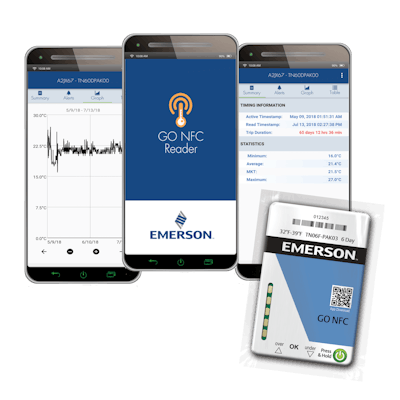 The GO NFC smart label from Emerson records historical time and temperature information and displays if temperature thresholds have been exceeded on its mobile app.
The GO NFC smart label from Emerson records historical time and temperature information and displays if temperature thresholds have been exceeded on its mobile app.
Data collected by smart labels can also be integrated into back-end cloud services for further analysis and insight. For example, cold chain data from Emerson’s loggers and trackers is integrated into its Oversight Cloud platform, where the company then provides aggregated cold chain information back to its customers.
The benefits of smart label data collection is being explored by a number of growing industry-wide initiatives and may prove essential in the successful deployment of blockchain technology.
Emerson recently joined the IBM Food Trust—a collaborative network of growers, processors, wholesalers, distributors, manufacturers, retailers and others, enhancing visibility and accountability across the food supply chain—where Childress says the company is leveraging its advanced cold chain technology to provide temperature-related information on in-transit, refrigerated cargo to improve shelf-life estimates and food freshness, enabling more actionable data for network members.
Built on IBM Blockchain, the food trust connects participants through a permissioned, immutable and shared record of food provenance, transaction data, processing details and more.
In 2008, an industry-led effort to enhance traceability throughout the entire produce supply chain was launched as the Produce Traceability Initiative (PTI). The PTI system is a voluntary program that helps companies track produce from its point of origin to a retail location where it is purchased by consumers. The initiative aims to create a standardized industry approach to how fresh produce products are labeled and tracked.
“Traceability codes, such as those promoted for use by the Produce Traceability Initiative, bring trace forward and trace back capabilities to the produce industry,” notes Childress. “These smart labels are a component of a system that makes it possible to track produce from its point of origin to a retail location.
“We’ve seen similar traceability codes used to validate the authenticity of pharmaceuticals and combat counterfeit drugs, and you will see a similar use in tracking high-value, luxury goods,” she adds.
Follow Amy Wunderlin on Twitter.











